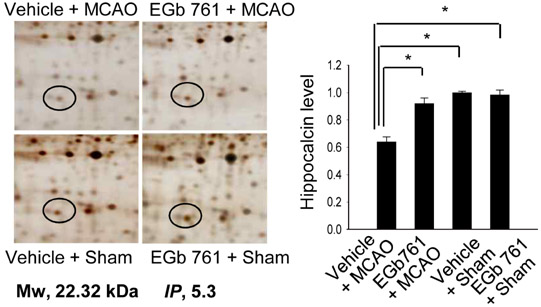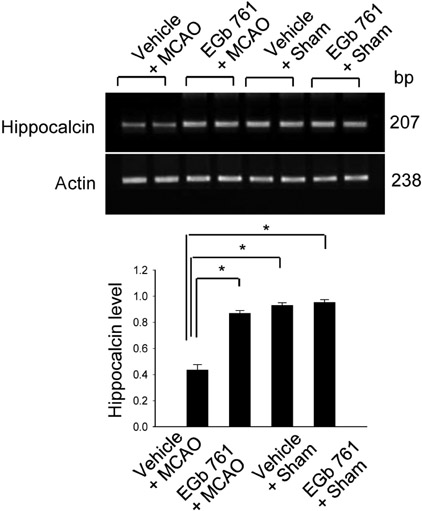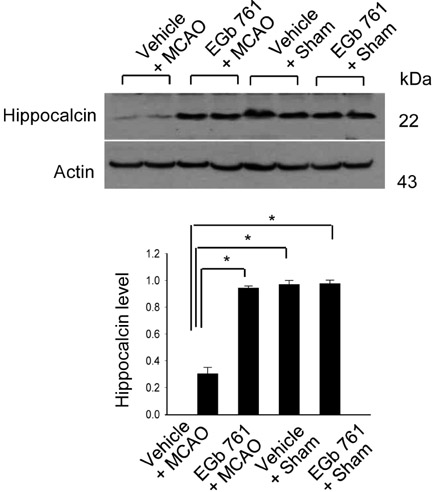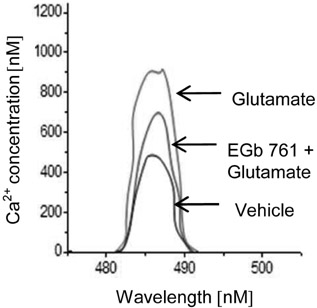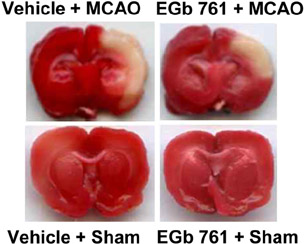Lab Anim Res.
2012 Sep;28(3):199-204. 10.5625/lar.2012.28.3.199.
Gingko biloba extract (EGb 761) attenuates ischemic brain injury-induced reduction in Ca2+ sensor protein hippocalcin
- Affiliations
-
- 1Department of Anatomy, College of Veterinary Medicine, Research Institute of Life Sciences, Gyeongsang National University, Jinju, Korea. pokoh@gnu.ac.kr
- KMID: 1436725
- DOI: http://doi.org/10.5625/lar.2012.28.3.199
Abstract
- Gingko biloba extract 761 (EGb 761) protects neuronal cells from ischemic brain injury via a number of neuroprotective mechanisms. Hippocalcin is a calcium sensor protein that regulates intracellular calcium concentrations and apoptotic cell death. We investigated whether EGb 761 regulates hippocalcin expression in cerebral ischemia. Male Sprague-Dawley rats were treated with vehicle or EGb 761 (100 mg/kg) prior to middle cerebral artery occlusion (MCAO), and cerebral cortex tissues were collected 24 h after MCAO. A proteomic approach demonstrated reduction in hippocalcin expression in vehicle-treated animals during MCAO, whereas EGb 761 treatment prevented injury-induced decreases in hippocalcin expression. RT-PCR and Western blot analyses indicated that EGb 761 attenuates injury-induced decrease in hippocalcin. These results suggest that the maintenance of hippocalcin during cerebral ischemia contributes to the neuroprotective role of EGb 761.
Keyword
MeSH Terms
Figure
Reference
-
1. Marcocci L, Maguire JJ, Droy-Lefaix MT, Packer L. The nitric oxide-scavenging properties of Ginkgo biloba extract EGb 761. Biochem Biophys Res Commun. 1994. 201(2):748–755.2. Droy-Lefaix MT, Cluzel J, Menerath JM, Bonhomme B, Doly M. Antioxidant effect of a Ginkgo biloba extract (EGb 761) on the retina. Int J Tissue React. 1995. 17(3):93–100.3. White HL, Scates PW, Cooper BR. Extracts of Ginkgo biloba leaves inhibit monoamine oxidase. Life Sci. 1996. 58(16):1315–1321.4. Oken BS, Storzbach DM, Kaye JA. The efficacy of Ginkgo biloba on cognitive function in Alzheimer disease. Arch Neurol. 1998. 55(11):1409–1415.5. Diamond BJ, Shiflett SC, Feiwel N, Matheis RJ, Noskin O, Richards JA, Schoenberger NE. Ginkgo biloba extract: mechanisms and clinical indications. Arch Phys Med Rehabil. 2000. 81(5):668–678.6. Smith JV, Luo Y. Elevation of oxidative free radicals in Alzheimer's disease models can be attenuated by Ginkgo biloba extract EGb 761. J Alzheimers Dis. 2003. 5(4):287–300.7. Manev H, Favaron M, Guidotti A, Costa E. Delayed increase of Ca2+ influx elicited by glutamate: role in neuronal death. Mol Pharmacol. 1989. 36(1):106–112.8. Heizmann CW, Hunziker W. Intracellular calcium-binding proteins: more sites than insights. Trends Biochem Sci. 1991. 16(3):98–103.9. Baimbridge KG, Celio MR, Rogers JH. Calcium-binding proteins in the nervous system. Trends Neurosci. 1992. 15(8):303–308.10. Bleakman D, Roback JD, Wainer BH, Miller RJ, Harrison NL. Calcium homeostasis in rat septal neurons in tissue culture. Brain Res. 1993. 600(2):257–267.11. Nitsch R, Leranth C, Frotscher M. Most somatostatin-immunoreactive neurons in the rat fascia dentata do not contain the calcium-binding protein parvalbumin. Brain Res. 1990. 528(2):327–329.12. Bastianetto S, Ramassamy C, Doré S, Christen Y, Poirier J, Quirion R. The Ginkgo biloba extract (EGb 761) protects hippocampal neurons against cell death induced by beta-amyloid. Eur J Neurosci. 2000. 12(6):1882–1890.13. Lee EJ, Chen HY, Wu TS, Chen TY, Ayoub IA, Maynard KI. Acute administration of Ginkgo biloba extract (EGb 761) affords neuroprotection against permanent and transient focal cerebral ischemia in Sprague-Dawley rats. J Neurosci Res. 2002. 68(5):636–645.14. Longa EZ, Weinstein PR, Carlson S, Cummins R. Reversible middle cerebral artery occlusion without craniectomy in rats. Stroke. 1989. 20(1):84–91.15. Koh PO. Gingko biloba extract (EGb 761) prevents cerebral ischemia-induced p70S6 kinase and S6 phosphorylation. Am J Chin Med. 2010. 38(4):727–734.16. Maher P, Davis JB. The role of monoamine metabolism in oxidative glutamate toxicity. J Neurosci. 1996. 16(20):6394–6401.17. Malgaroli A, Milani D, Meldolesi J, Pozzan T. Fura-2 measurement of cytosolic free Ca2+ in monolayers and suspensions of various types of animal cells. J Cell Biol. 1987. 105(5):2145–2155.18. Grynkiewicz G, Poenie M, Tsien RY. A new generation of Ca2+ indicators with greatly improved fluorescence properties. J Biol Chem. 1985. 260(6):3440–3450.19. Clark WM, Rinker LG, Lessov NS, Lowery SL, Cipolla MJ. Efficacy of antioxidant therapies in transient focal ischemia in mice. Stroke. 2001. 32(4):1000–1004.20. Chandrasekaran K, Mehrabian Z, Spinnewyn B, Chinopoulos C, Drieu K, Fiskum G. Neuroprotective effects of bilobalide, a component of Ginkgo biloba extract (EGb 761) in global brain ischemia and in excitotoxicity-induced neuronal death. Pharmacopsychiatry. 2003. 36:Suppl 1. S89–S94.21. Koh PO. Gingko biloba extract (EGb 761) prevents increase of Bad-Bcl-XL interaction following cerebral ischemia. Am J Chin Med. 2009. 37(5):867–876.22. Sung JH, Shah FA, Cho EH, Gim SA, Jeon SJ, Kim KM, Kim YM, Kim MO, Koh PO. Ginkgo biloba extract (EGb 761) prevents the ischemic brain injury-induced decrease in parvalbumin expression. Lab Anim Res. 2012. 28(2):77–82.23. Nitsch C, Scotti A, Sommacal A, Kalt G. GABAergic hippocampal neurons resistant to ischemia-induced neuronal death contain the Ca2(+)-binding protein parvalbumin. Neurosci Lett. 1989. 105(3):263–268.24. Kristián T, Siesjö BK. Calcium in ischemic cell death. Stroke. 1998. 29(3):705–718.25. Hayashi T, Abe K. Ischemic neuronal cell death and organellae damage. Neurol Res. 2004. 26(8):827–834.26. Starkov AA, Chinopoulos C, Fiskum G. Mitochondrial calcium and oxidative stress as mediators of ischemic brain injury. Cell Calcium. 2004. 36(3-4):257–264.27. Bano D, Nicotera P. Ca2+ signals and neuronal death in brain ischemia. Stroke. 2007. 38(2):674–676.
- Full Text Links
- Actions
-
Cited
- CITED
-
- Close
- Share
- Similar articles
-
- Ginkgo biloba extract (EGb 761) prevents the ischemic brain injury-induced decrease in parvalbumin expression
- Identification of a Novel Function of Extract of Gingko biloba (EGb 761®) as a Regulator of PYY Secretion and FFA4 Activation
- An experimental study on the effect of Ginkgo Biloba extract (EGb 761) on the healing process after weak crush injury
- Effect of Ginkgo Biloba Extract(EGb 761) on Apoptosis in Oral Cavity Cancer Cells
- Suppression of IL-1beta-induced MUC5AC Gene Expression by Ginkgo biloba Extract(EGb 761) in Human Airway Epithelial Cells

